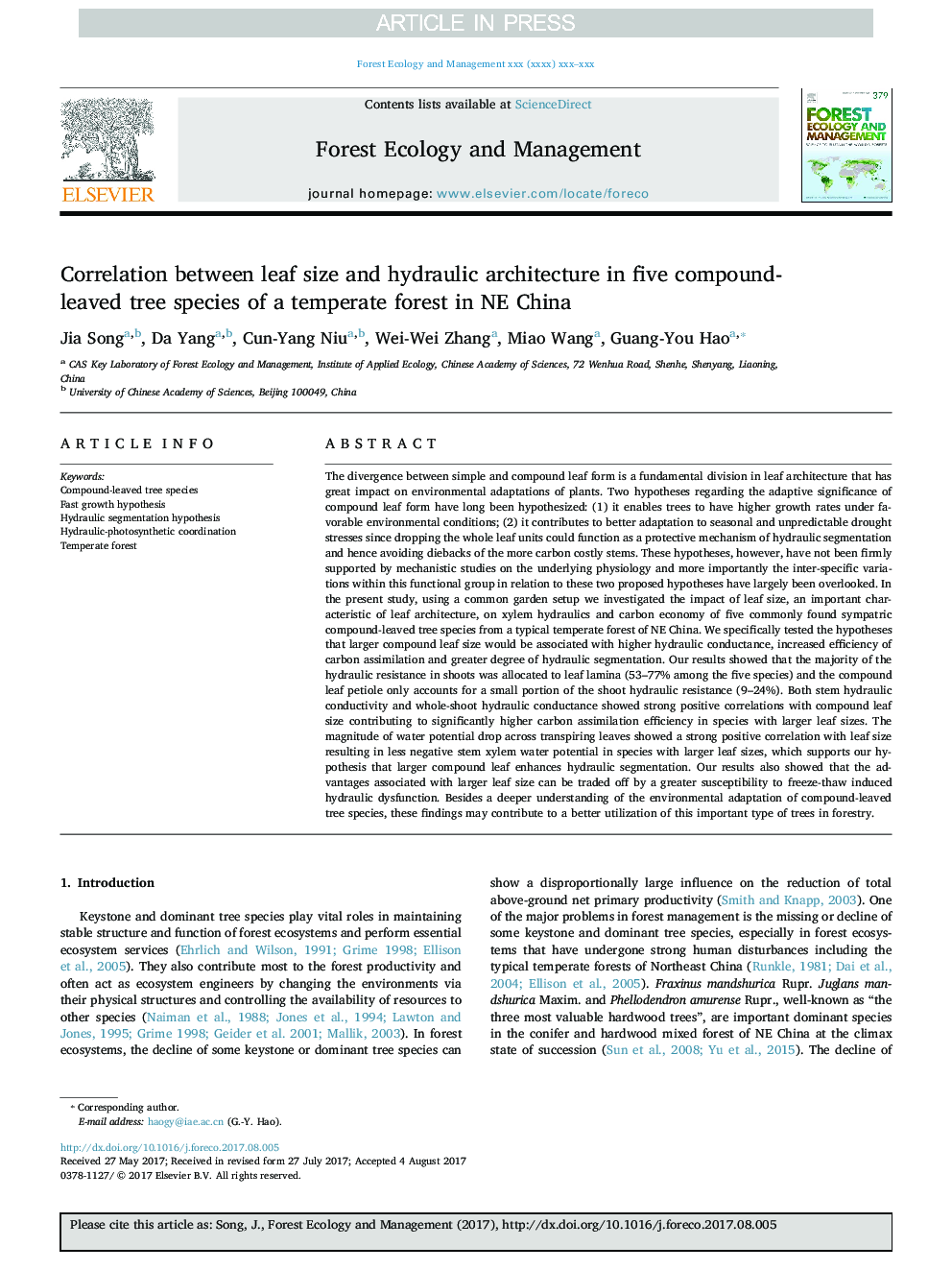| کد مقاله | کد نشریه | سال انتشار | مقاله انگلیسی | نسخه تمام متن |
|---|---|---|---|---|
| 6541732 | 1421341 | 2018 | 10 صفحه PDF | دانلود رایگان |
عنوان انگلیسی مقاله ISI
Correlation between leaf size and hydraulic architecture in five compound-leaved tree species of a temperate forest in NE China
ترجمه فارسی عنوان
همبستگی بین اندازه برگ و معماری هیدرولیکی در پنج گونه درخت جنگلی مرکب جنگلی معتدل در شمال غربی چین
دانلود مقاله + سفارش ترجمه
دانلود مقاله ISI انگلیسی
رایگان برای ایرانیان
کلمات کلیدی
گونه های درخت انجیر، فرضیه رشد سریع، فرضیه تقسیم هیدرولیکی، هماهنگ سازی هیدروژنی-فتوسنتزی، جنگل معتدل،
ترجمه چکیده
واگرایی بین شکل برگ ساده و مرکب، یک بخش اساسی در معماری برگ است که تأثیر زیادی بر سازگاری زیست محیطی گیاهان دارد. دو فرضیه در مورد اهمیت تطبیقی فرم برگ مرکب به مدت طولانی فرض شده است: (1) درختان را قادر می سازد که نرخ رشد بالاتر در شرایط محیطی مطلوب؛ (2) سازگاری بهتر با تنش های فصلی و غیر قابل پیش بینی خشکسالی را در بر می گیرد؛ زیرا حذف کل واحدهای برگ می تواند به عنوان یک مکانیزم حفاظتی از تقسیم بندی هیدرولیکی عمل کند و از این رو اجتناب از خستگی بیشتر ساقه های گران قیمت کربن. با این حال، این فرضیه ها به واسطه مطالعات مکانیکی بر فیزیولوژی پایه ای تأیید نشده است و مهمتر از همه، تغییرات متقابل خاص در این گروه عملکردی در ارتباط با این دو فرضیه پیشنهاد شده به طور عمده مورد توجه قرار نگرفته است. در مطالعه حاضر با استفاده از یک گیاه باغچه ای مشترک، تاثیر اندازه برگ، ویژگی مهمی از معماری برگ، بر روی هیدرولیک کیسیلم و اقتصاد کربن پنج گونه معمولی گونه های ترکیبی سم پطری از چوب جنگلی معمولی شمال غربی چین مورد بررسی قرار گرفت. ما به طور خاص فرضیه ها را بررسی می کنیم که اندازه برگ های بزرگ تر ترکیب شده با هدایت هیدرولیکی بالاتر، افزایش کارایی جذب کربن و افزایش درجه بندی هیدرولیکی می شود. نتایج ما نشان داد که اکثریت مقاومت هیدرولیک در شاخه ها به لامین برگ (77- 53 درصد از میان پنج گونه) اختصاص داده شده است و تراکم برگ مرکب فقط برای بخش کوچکی از مقاومت هیدرولیک ساقه (24-9 درصد) است. هر دو هدایت هیدرولیکی ساقه و هدایت هیدرولیکی کل پیوسته نشان دهنده همبستگی مثبت شدید با اندازه برگ های ترکیب شده است که باعث افزایش کارایی جذب کربن در گیاهان با گونه های بزرگتر برگ می شود. افت پتانسیل آب در برگ های مرطوب نشان دهنده همبستگی مثبت و قوی با اندازه برگ است که منجر به کم شدن پتانسیل آب منفی خاکستری در گونه های با اندازه های بزرگتر برگ می شود، که از فرض ما این است که برگ های بزرگتر باعث افزایش بخش بندی هیدرولیکی می شوند. نتایج ما نیز نشان داد که مزایای مرتبط با اندازه بزرگتر برگ را می توان با حساسیت بیشتر به اختلال عملکرد هیدرولیکی ناشی از یخ زدگی معامله کرد. علاوه بر درک عمیق تر از سازگاری زیست محیطی گونه های درخت مرکب، این یافته ها می تواند به استفاده بهتر از این نوع مهم درختان در جنگل کمک کند.
موضوعات مرتبط
علوم زیستی و بیوفناوری
علوم کشاورزی و بیولوژیک
بوم شناسی، تکامل، رفتار و سامانه شناسی
چکیده انگلیسی
The divergence between simple and compound leaf form is a fundamental division in leaf architecture that has great impact on environmental adaptations of plants. Two hypotheses regarding the adaptive significance of compound leaf form have long been hypothesized: (1) it enables trees to have higher growth rates under favorable environmental conditions; (2) it contributes to better adaptation to seasonal and unpredictable drought stresses since dropping the whole leaf units could function as a protective mechanism of hydraulic segmentation and hence avoiding diebacks of the more carbon costly stems. These hypotheses, however, have not been firmly supported by mechanistic studies on the underlying physiology and more importantly the inter-specific variations within this functional group in relation to these two proposed hypotheses have largely been overlooked. In the present study, using a common garden setup we investigated the impact of leaf size, an important characteristic of leaf architecture, on xylem hydraulics and carbon economy of five commonly found sympatric compound-leaved tree species from a typical temperate forest of NE China. We specifically tested the hypotheses that larger compound leaf size would be associated with higher hydraulic conductance, increased efficiency of carbon assimilation and greater degree of hydraulic segmentation. Our results showed that the majority of the hydraulic resistance in shoots was allocated to leaf lamina (53-77% among the five species) and the compound leaf petiole only accounts for a small portion of the shoot hydraulic resistance (9-24%). Both stem hydraulic conductivity and whole-shoot hydraulic conductance showed strong positive correlations with compound leaf size contributing to significantly higher carbon assimilation efficiency in species with larger leaf sizes. The magnitude of water potential drop across transpiring leaves showed a strong positive correlation with leaf size resulting in less negative stem xylem water potential in species with larger leaf sizes, which supports our hypothesis that larger compound leaf enhances hydraulic segmentation. Our results also showed that the advantages associated with larger leaf size can be traded off by a greater susceptibility to freeze-thaw induced hydraulic dysfunction. Besides a deeper understanding of the environmental adaptation of compound-leaved tree species, these findings may contribute to a better utilization of this important type of trees in forestry.
ناشر
Database: Elsevier - ScienceDirect (ساینس دایرکت)
Journal: Forest Ecology and Management - Volume 418, 1 June 2018, Pages 63-72
Journal: Forest Ecology and Management - Volume 418, 1 June 2018, Pages 63-72
نویسندگان
Jia Song, Da Yang, Cun-Yang Niu, Wei-Wei Zhang, Miao Wang, Guang-You Hao,
